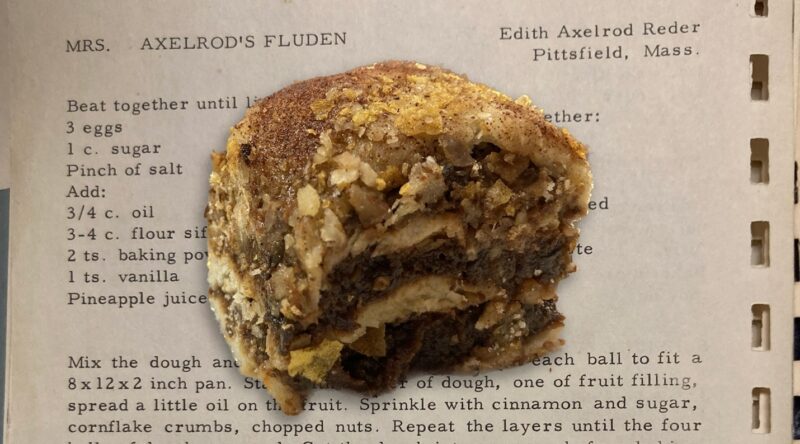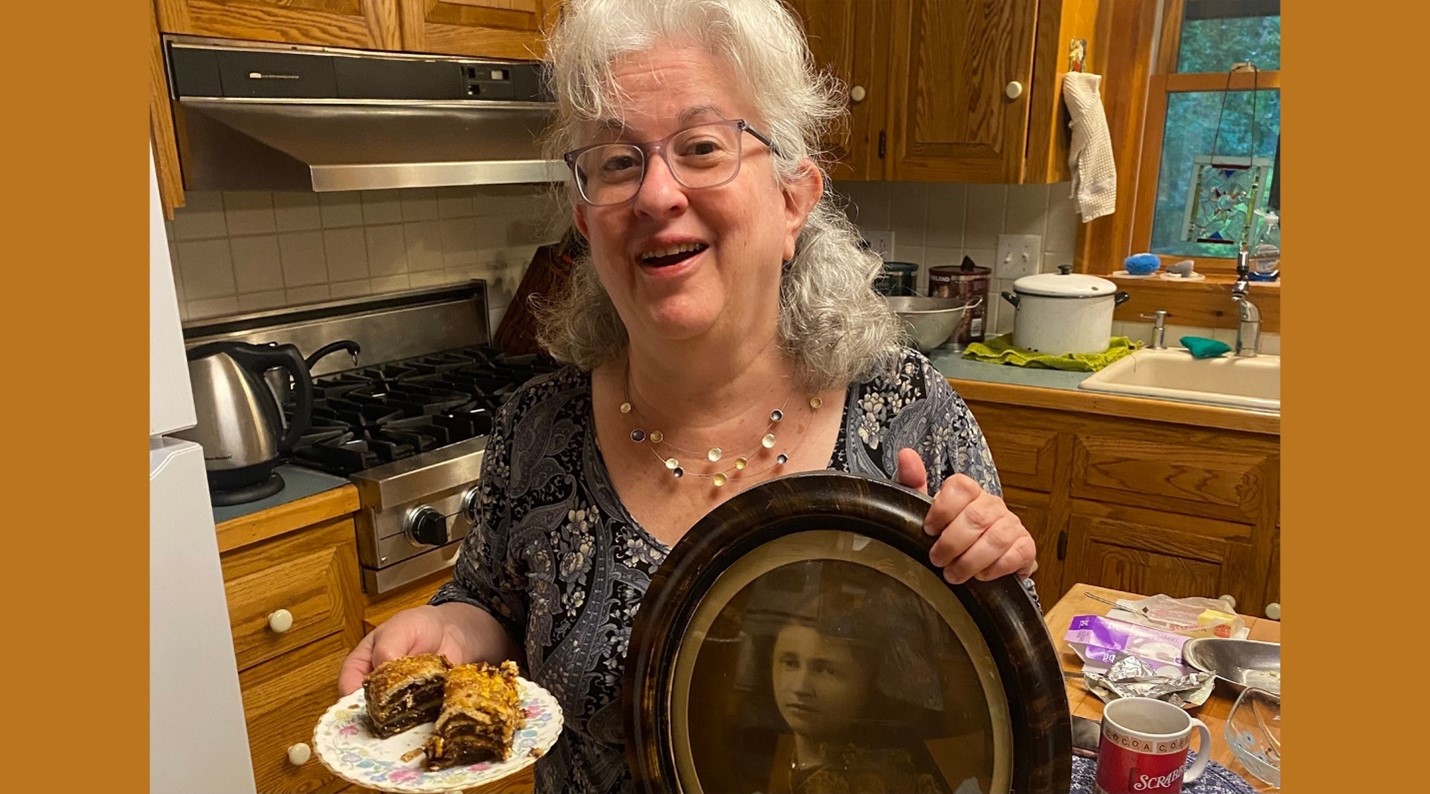
This High Holiday pastry connects me to the relatives I loved and the ones I lost.Â
There was a small bedroom in my Zeyde’s house on State Road in Great Barrington, Massachusetts, that had no radiator. It was called “the cold room.†It was crammed with furniture: two twin beds and a couple of dressers. On Rosh Hashanah, you would find a large baking dish covered with a dish towel sitting on top of one of those dressers. Take a peek under the towel, and there it was: Fluden.
Fluden is a holiday dessert that resembles a sweet lasagna: layers of prune, orange and pineapple filling between four layers of rolled-out dough, with a crunchy, cinnamon and nutty topping. My aunts would prepare it each year, in a ritual that was just as much a part of the season as tossing stones into the Housatonic River for tashlich, or hearing my zeyde, Rabbi Jacob Axelrod, blow the shofar in his synagogue up the hill, or catching games of the World Series between Rosh Hashanah and Yom Kippur. The fluden would sit on the dresser and never had to be served, because there was a knife in the dish and you could cut off a slice of the pareve delicacy whenever the spirit moved you. Over the course of the holiday it would gradually shrink, until someone would announce that it was all gone. Fertig.
Never did I see this dish in any bakery, or in anyone else’s home. And yet it was integral to our holiday experience, even more than the teyglach we would sometimes buy from Michelle’s bakery near our home in Plainview, Long Island: little hard balls of cookie dough piled into a pyramid the size of a hat, drenched with honey and nuts and maraschino cherries. This was fun and messy to pick apart. But for flavor and comfort, nothing could beat fluden.
Though my aunts were the bakers, it was my mother, Peggy — their sister-in-law — who preserved the recipe for posterity in written form. Mom later described how she watched and took notes as her mother-in-law, Beile, step by step mixed and rolled the dough, chopped and pulverized the filling and assembled the layers one by one. There were no accurate measures: as my mother recalled, Beile just took pinches of this or that, cups of this or that. The result would be this holiday delicacy that everyone craved.
However, there was a downside to fluden, and it was the reason why it would take a few days for it to disappear. There was a general understanding that you didn’t want to eat too much of it at once. All I need to say here is: prunes.
Just up the street from the house was my zeyde’s synagogue, Ahavath Sholom, where about 100 worshippers could gather. He had been hired as rabbi in 1927, two years after he emigrated from Poland. On the shul’s hard wooden pews were long cushions covered in faded red fabric. There was no mechitzah separating men from women — family legend has it that Beile had ripped it down, since no one had felt responsible to keep it clean and tidy.
I don’t have many memories of my baba, Beile, but certainly she was a great baker. I distinctly recall the oohs and ahhs as her huckleberry pies or little challah rolls were brought to the table, held seemingly way above me and handed around. Baba died before I turned five, of complications from diabetes.
I remember my zeyde only without her. On the holiday, he would lead the service from a small lectern, occasionally slamming his hand down to stop the chattering in the background. The windows in the small sanctuary were always kept shut, as zeyde would refuse to continue the service if he sensed a breeze.
In order to get some air, you would have to “take a break†and walk down the hill past zeyde’s little kosher store. From there you might pass his garden, pass clothesline and the shed that doubled as a sukkah, enter the house via the kitchen, slip through the dining room and into the living room, then make a hard left between the couch and the bookshelf holding zeyde’s “Vilna Shas†Talmud, into the cold room for a bite of fluden.
In 1966, my aunt Edith shared the recipe in the “Mother’s Way Cookbook,†published by the Hebrew Ladies Aid Society of Ahavath Sholom Synagogue and the Hadassah Chapter of Great Barrington. It’s on page 36, between Helen Natelson’s “Speedy Sponge Cake†and Blanche Bradford’s “Spice Cake.†As with other aspects of transplanted European Jewish culture, like the Yiddish language itself, Americanisms crept into the list of ingredients. I am sure there were no cornflakes in my ancestors’ shtetl, Luboml, and no canned pineapple, either.
Many years later, my mother excitedly reported that she had found a recipe for fluden in “The World of Jewish Cooking,â€Â by Gil Marks. Up to then, no Jewish cookbook had completely satisfied her, since she had never found fluden in the index.
But there it was, on page 339: Fluden, Ashkenazic layered pastry. According to Marks, the dish could have various fillings, and was sometimes even made with cheese. The first recorded reference dates back to around the year 1000 C.E., when Rabbi Gershom ben Yehudah of Mainz, Germany, describes an argument between two rabbis about whether one could “eat bread with meat even if it was baked in an oven with a cheese dish called fluden.â€
The layers, Marks writes, “were symbolic of both the double portion of manna collected for the Sabbath and the lower and upper layers of dew that protected the manna.†Fruit and nut fillings were most common on Sabbath, he adds. Today, a similar, layered fruit pastry called apfelschalet is served by Jews from the Alsace region. In Hungary, there is a layered desert called flodni, and in parts of Eastern Europe there is a layered strudel called gebleterter kugel.
Fluden is much more than a holiday dessert for me. It is a symbol of generational continuity despite the Holocaust, which ripped a hole in our family history. It connects me to the women who were the carriers of tradition – the doers and the recorders. And, in its glistening, fragrant glory, it is also a key to the door of memory, which opens with a creak of rusty springs and reveals the scene unfolding.
The kitchen, the rolled-up sleeves, the aprons, the rolling pin, the gossip. Zeyde in his slippers and robe shuffling through. The two ovens, both working overtime. Children under foot. The light switch cord hanging down over the table, with its bobbin-like pull. Next to the sink, the window with its filmy curtains, looking out across the yard and vegetable garden, toward the shul.
For us, the dish was a once-a-year treat. I have prepared my baba’s recipe several times, and will try my hand at it again this year, with quite a bit less sugar than suggested. (I inherited the diabetes, too.) My kitchen is just a couple of miles away from where my zeyde and baba’s house once stood. On that spot, there is now a sporting goods shop that my sister likes to call “Zeyde’s Bike and Board.†The older generation is nearly all gone, buried in the Ahavath Sholom cemetery on Blue Hill Road. We have inherited many traditions, keeping some, eschewing others. But in my family, where there is fluden, there will always be followers, ready to cut a slice — a small slice! — for breakfast, lunch or dinner.
Toby Axelrod poses with pieces of her latest batch of fluden and a photograph of her grandmother, Beile Lichtenstein Axelrod. (Courtesy of Toby Axelrod)

Mrs. Axelrod’s Fluden
Edith Axelrod Reder
Pittsfield, Mass.Â
Beat together until light and fluffy:
3 eggs
1 c. sugar
Pinch of salt
Add:Â
¾ c. oil
3-4 c. flour sifted with
2 tsp. baking powder
1 tsp. vanilla
Pineapple juice (from filling)
Filling:Â
Grind together
2 lbs. sour prunes
1 orange
1 lemon, add:
# 2 can drained, crushed pineapple
Jam and sugar to taste
Cinnamon and sugar
Chopped nuts
Crushed cornflakes
Directions:
Mix the dough and knead into 4 balls. Roll out each ball to fit a 8 x 12 x 2 inch pan. Start with a layer of dough, one of fruit filling, spread a little oil on the fruit. Sprinkle with cinnamon and sugar, cornflake crumbs, chopped nuts. Repeat the layers until the balls of dough are used. Cut the dough into squares before baking. Oven set at 350 degrees for 35-40 minutes.Â
From “Mother’s Way Cookbook†(Hebrew Ladies Aid Society of Ahavath Sholom Synagogue and the Hadassah Chapter of Great Barrington)
